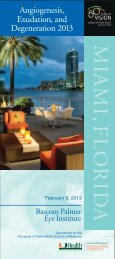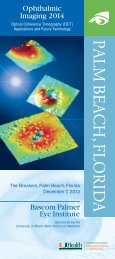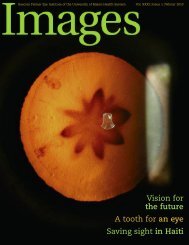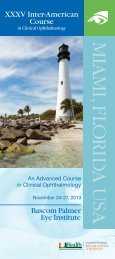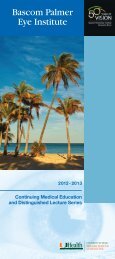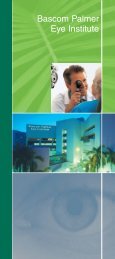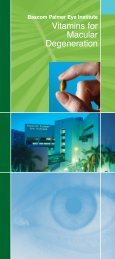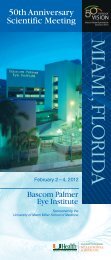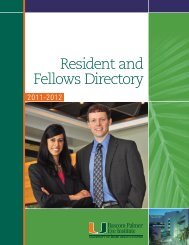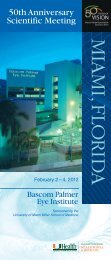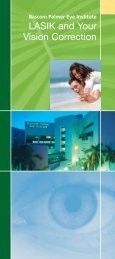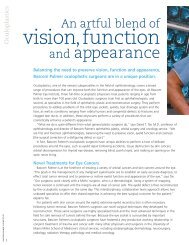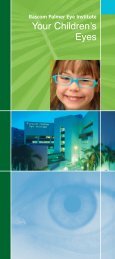Images Magazine Spring 2013 - Bascom Palmer Eye Institute
Images Magazine Spring 2013 - Bascom Palmer Eye Institute
Images Magazine Spring 2013 - Bascom Palmer Eye Institute
- No tags were found...
Create successful ePaper yourself
Turn your PDF publications into a flip-book with our unique Google optimized e-Paper software.
In 1982, <strong>Bascom</strong> <strong>Palmer</strong>’s clinicians performedapproximately 4,000 laser procedures.featureAt this time, <strong>Bascom</strong> <strong>Palmer</strong>’s researchers were studying how to use lasers to cut corneal tissue,treat diseased tissue inside the eye and prevent the growth of abnormal scar tissue or tumor cellsinside the eye. Meanwhile, <strong>Bascom</strong> <strong>Palmer</strong>’s clinicians were quick to put this advanced technology toclinical use. In 1982, they performed approximately 4,000 laser procedures. Ophthalmologists beganusing the excimer laser to reshape the cornea in a procedure known as photorefractive keratectomy.Lasers helped <strong>Bascom</strong> <strong>Palmer</strong>’s physicians treat many other types of vision problems. By theearly 1990s, the U.S. Food and Drug Administration (FDA) had approved clinical trials with lasersfor correcting nearsightedness, farsightedness and astigmatism. FDA approval for LASIK and otherrefractive surgeries came in 1995.In 1988, Clarkson directed a multicenter central vein occlusion study, examining a retinal disorderthat causes bleeding from retinal blood vessels. Funded by the National <strong>Eye</strong> <strong>Institute</strong> (NEI), the studylooked at whether early photocoagulation (laser) therapy was the best treatment to prevent furthercomplications and loss of vision.Meanwhile, Knighton was conducting laboratory research on the retinal nerve fiber layer, whichis damaged by glaucoma at an early stage well before the loss of visual sensitivity. His work led theway to better explanations of why some nerve bundles worked better than others. “There is a hugebenefit to being a researcher in a clinical department,” said Knighton. “You can interact with thephysicians and learn what would be most useful to them. Later on, you can see the results of yourlaboratory work being put into practice in the patients’ eye clinics.”After joining the faculty in 1986, Eduardo C. Alfonso, M.D., focused his research and clinicalactivities on corneal transplants, infections of the cornea and ocular pathology. Alfonso became medicaldirector of the ocular microbiology laboratory and began studying artificial corneas, which could beused for patients awaiting transplants in developing nations where donor tissue is often scarce.Advances in <strong>Eye</strong> CareSoon after David T. Tse, M.D., joined the <strong>Bascom</strong> <strong>Palmer</strong> faculty in 1986, he was faced with anextremely challenging case. A 21-year-old patient was facing a deadly cancerous tumor in the tearproducinglacrimal gland that extended all the way into his brain. “Based on actuarial data at thattime, 80 percent of all patients with this lethal orbital tumor would die within ten years,” said Tse.“We decided to try something new in order save this young man’s life.”1991 FactsNumber of patients103,6200Surgical procedures8,3691993William W.Culbertson,M.D.,identifies theherpes virus asa cause of acuteretinal necrosis,a devastatinginfection of theretina.1993Janet Davis, M.D., M.A.leads the fight to savevision in AIDS-relatedeye disease.13



